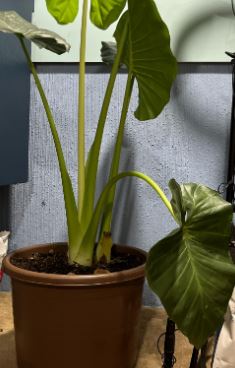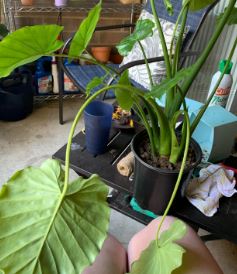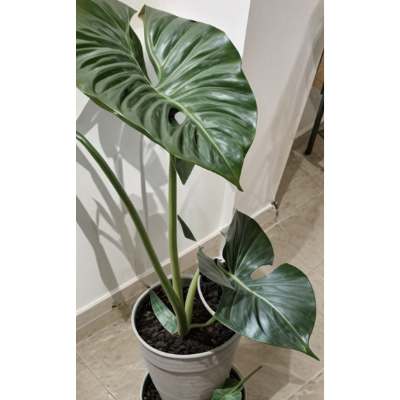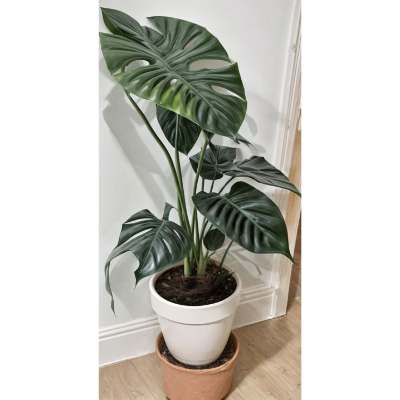Elephant ear plants, known for their large, stunning leaves, can face the common issue of drooping. This guide aims to delve into the various aspects of why your elephant ear plant might be drooping and how to address this concern effectively.
Elephant ear plants is drooping due to insufficient sunlight, improper watering, or nutrient deficiencies. Ensure they receive at least six hours of direct sunlight, maintain well-draining soil, and provide balanced fertilization. Staking can support heavy leaves, while addressing post-transplant stress and monitoring seasonal needs ensures a healthy, upright plant.
Introduction
Elephant ear plants, scientifically classified under the genus Colocasia or Alocasia, are renowned for their grandeur and lush foliage. However, enthusiasts often encounter the perplexing issue of their elephant ear plants exhibiting a drooping demeanor. This guide aims to unravel the mysteries behind elephant ear plant drooping, providing insights into the multiple factors contributing to this phenomenon and offering practical solutions for plant enthusiasts.
Factors Contributing to Elephant Ear Plant Drooping
Light Conditions
Insufficient sunlight is a common culprit behind elephant ear plant drooping. These plants thrive on direct sunlight for at least six hours a day. Inadequate exposure can lead to weakened stems and drooping leaves. To remedy this, consider relocating your plant to a sunnier spot or supplementing natural light with artificial sources.
Insufficient sunlight affects the metabolic processes within the plant, hindering its ability to maintain an upright posture. When the plant doesn’t receive an adequate amount of sunlight, the production of essential nutrients is compromised, impacting its overall health and structural integrity.
In addition to relocating the plant, ensure that the selected area provides the right balance of sunlight. Elephant ear plants may tolerate partial sun, but a careful balance is crucial to prevent both drooping and leaf scorching.
Proper sunlight exposure is not only essential for overall plant health but also influences its aesthetic appeal. Lush, upright leaves contribute to the visual appeal of elephant ear plants, making it imperative to address any drooping issues promptly.
In cases where natural sunlight is insufficient, supplementing with artificial light sources can prove beneficial. Be mindful of the duration and intensity of artificial light to mimic natural conditions as closely as possible.

Watering Practices
Elephant ear plants demand consistent moisture levels in the soil, and deviations can lead to drooping. The ideal soil for these plants is evenly moist but not waterlogged. Overwatering or underwatering can disrupt this balance, causing stress to the plant.
Inadequate watering can result in soil dryness, prompting the elephant ear plant to droop. To address this, thoroughly soak the soil when it becomes extremely dry, allowing the plant to absorb water and regain turgidity.
Conversely, overwatering can lead to root rot, a condition that compromises the plant’s ability to absorb nutrients and water. This can manifest as drooping leaves. Ensure proper drainage in the planting container and adjust the watering frequency to maintain optimal soil moisture.
Balancing the watering routine is crucial for preventing drooping and promoting the overall well-being of the elephant ear plant. Monitor the soil consistently, adjusting the watering frequency based on environmental conditions and the plant’s specific needs.
It’s important to note that water quality also plays a role in plant health. If using tap water, be mindful of potential contaminants and consider using filtered or distilled water to maintain the plant’s optimal condition.
Fertilization Needs
Fertilizers contribute significantly to the health and vigor of elephant ear plants. Nutrient deficiencies can manifest as drooping leaves, signaling the need for a well-balanced fertilizer.
The elephant ear plant’s nutrient requirements vary throughout its growth stages. During active growth, a balanced, water-soluble fertilizer with equal proportions of nitrogen, phosphorus, and potassium is ideal. This promotes healthy foliage development and overall plant vitality.
Incorporate organic matter into the soil to enhance nutrient availability. Well-rotted compost or organic fertilizers can provide a slow-release nutrient source, sustaining the plant over an extended period.
Avoid excessive fertilizer application, as this can lead to salt buildup in the soil, negatively impacting the plant’s roots. Follow the recommended application rates on the fertilizer packaging, adjusting based on the plant’s response and specific environmental conditions.
Consider conducting a soil test to identify any existing nutrient deficiencies. This allows for targeted fertilizer application, addressing specific deficiencies and promoting optimal plant health.

Leaf Weight and Support
The elephant ear plant’s large leaves, while visually striking, can become a burden for the stems, leading to drooping. Supporting the leaves through staking is a practical solution to prevent this issue.
Staking involves providing external support to the plant, helping it maintain an upright posture despite the weight of its leaves. This technique is particularly beneficial for mature plants with large, heavy foliage.
Choose stakes that are tall enough to provide adequate support for the entire plant. Position the stakes around the plant, avoiding damage to the roots. Secure the stems to the stakes using soft ties or twine, allowing for flexibility as the plant continues to grow.
Regularly inspect the staking arrangement to ensure stability and make adjustments as needed. As the plant matures, the staking requirements may change, requiring additional support or modifications to the existing setup.
Staking not only addresses the issue of drooping but also enhances the overall aesthetic appeal of the elephant ear plant. Properly supported, the plant can showcase its grandeur with upright, healthy leaves.

Nutrient Deficiency in Elephant Ear Plants
Apart from the general nutrient requirements, specific deficiencies can contribute to drooping in elephant ear plants. Identifying these deficiencies and addressing them promptly is crucial for maintaining plant health.
Nitrogen Deficiency
Nitrogen is a vital nutrient for leafy green plants like the elephant ear. A deficiency in nitrogen can result in yellowing leaves and overall poor growth. To address this issue, consider applying a nitrogen-rich fertilizer, following the recommended dosage for your specific plant.
Phosphorus Deficiency
Phosphorus is essential for root development and overall plant energy transfer. A phosphorus deficiency may manifest as stunted growth and darkening of the leaves. Choose a fertilizer with a higher phosphorus content to rectify this deficiency, ensuring proper root system development.
Potassium Deficiency
Potassium plays a crucial role in water uptake and nutrient transportation within the plant. A potassium deficiency can lead to weak stems and drooping leaves. Select a fertilizer with balanced potassium content to remedy this issue and promote structural strength in the plant.
Calcium Deficiency
Calcium contributes to cell wall structure and overall plant rigidity. A deficiency in calcium can result in distorted leaves and weakened stems. Consider adding calcium-rich amendments to the soil, such as gypsum or crushed eggshells, to address this deficiency and enhance the plant’s structural integrity.
Magnesium Deficiency
Magnesium is essential for chlorophyll production and overall photosynthesis. A magnesium deficiency can cause yellowing between leaf veins, impacting the plant’s ability to generate energy. Apply magnesium-containing fertilizers or supplements to rectify this deficiency and restore the plant’s vibrant green color.
Iron Deficiency
Iron is crucial for chlorophyll formation and overall plant health. A deficiency in iron can lead to yellowing leaves with green veins. Use iron-rich fertilizers or foliar sprays to address this deficiency and promote healthy leaf coloration.
Addressing nutrient deficiencies requires a targeted approach, incorporating the appropriate fertilizers or amendments based on the specific needs of the plant. Regular monitoring and timely intervention contribute to the overall well-being of the elephant ear plant.

Post-Transplant Drooping
Transplanting is a common practice in gardening, but it can present challenges for elephant ear plants. Understanding the factors contributing to post-transplant drooping is essential for ensuring a smooth transition for the plant.
Common Challenges After Transplantation
Elephant ear plants may experience stress and drooping after being transplanted. This is a natural response to the disruption of their root system and the adjustment to a new environment. Several factors contribute to post-transplant drooping:
- Root Shock: The process of transplanting can lead to shock for the plant’s root system. This shock disrupts normal physiological processes, including water absorption, leading to temporary drooping.
- Environmental Change: Moving the plant to a new location with different light, temperature, and humidity levels can trigger stress. The plant may take some time to acclimate to these changes, during which drooping may occur.
- Soil Variations: Variances in soil composition between the original and new planting sites can impact water retention and nutrient availability. The plant may respond with drooping as it adjusts to these soil differences.
Strategies to Address Drooping Post-Transplant
- Gradual Acclimatization: To minimize transplant shock, gradually acclimate the elephant ear plant to its new environment. Introduce it to the new location in stages, allowing the plant to adjust to changes in light and other environmental factors.
- Proper Watering: Ensure that the plant receives adequate water after transplanting. However, avoid overwatering, as this can exacerbate stress and hinder root recovery. Monitor the soil moisture carefully and adjust watering frequency based on the plant’s needs.
- Protective Measures: Provide temporary protection from harsh sunlight or strong winds during the initial days post-transplant. This shields the plant from additional stressors, allowing it to focus on root recovery.
- Nutrient Support: Supplement the plant with a balanced, water-soluble fertilizer to support its recovery. This helps replenish nutrients lost during the transplant process, promoting healthy growth and minimizing drooping.
Addressing post-transplant drooping requires patience and attentive care. By implementing these strategies, you can facilitate a smoother transition for your elephant ear plant, allowing it to thrive in its new environment.
Troubleshooting Elephant Ear Plant Issues
While drooping is a common concern, elephant ear plants may experience other issues that can affect their overall health and appearance. Understanding these problems and implementing appropriate solutions is key to maintaining a vibrant and robust plant.
Yellowing Leaves
Yellowing leaves in elephant ear plants can be indicative of underlying issues such as overwatering or underwatering. It’s essential to identify the specific cause and take corrective measures to restore the plant’s vitality.
Overwatering vs. Underwatering
- Overwatering: Excess moisture in the soil can lead to oxygen deprivation in the roots, causing yellowing leaves. To address this, allow the soil to dry out between waterings and adjust the watering frequency accordingly.
- Underwatering: Insufficient water uptake can result in yellowing leaves due to nutrient deficiencies. Thoroughly water the plant when the top inch of soil feels dry, ensuring proper hydration and nutrient absorption.
Remedies for Yellowing Leaves
- Adjust Watering Practices: Strike a balance between keeping the soil consistently moist and avoiding waterlogging. Adjust the watering schedule based on environmental conditions and the plant’s specific needs.
- Check Soil Drainage: Ensure that the planting container has adequate drainage to prevent water accumulation. Consider repotting if the current container hinders proper drainage.
- Inspect Root Health: Examine the roots for signs of rot or decay. Trim any damaged roots and repot the plant if necessary, providing fresh, well-draining soil.
- Supplement with Nutrients: If nutrient deficiency is suspected, apply a balanced fertilizer to replenish essential nutrients. Follow recommended application rates to avoid over-fertilization.
Addressing yellowing leaves involves a comprehensive approach, considering both water management and nutrient supplementation. By identifying the specific cause of yellowing, you can implement targeted solutions to restore the plant’s health.
Brown Leaves
The browning of elephant ear plant leaves can be attributed to various factors, including environmental stress, disease, or inadequate care. Diagnosing the specific cause is crucial for implementing effective remedies.
Causes of Browning
- Environmental Stress: Exposure to extreme temperatures, sunlight, or harsh weather conditions can lead to leaf browning. Protect the plant from adverse conditions and provide appropriate shelter when needed.
- Disease or Pests: Fungal infections or pest infestations can cause brown spots or patches on the leaves. Inspect the plant regularly for signs of diseases or pests, and apply appropriate treatments if identified.
Steps to Revitalize Brown Leaves
- Prune Affected Areas: Trim brown or damaged sections of the leaves using sterilized pruning shears. This promotes air circulation and prevents further spread of the issue.
- Apply Fungicides or Insecticides: If a fungal infection or pest infestation is detected, use suitable fungicides or insecticides as per the manufacturer’s instructions. Ensure thorough coverage of the affected areas.
- Improve Environmental Conditions: Create a favorable environment for the plant by maintaining optimal temperature, humidity, and light levels. Consider relocating the plant if it is consistently exposed to adverse conditions.
- Monitor Watering Practices: Ensure proper watering to prevent both overhydration and underwatering, as extremes in soil moisture can contribute to leaf browning. Adjust the watering routine based on the plant’s needs and environmental factors.
Addressing brown leaves involves a combination of preventive measures and targeted interventions. By identifying the underlying cause, you can implement appropriate strategies to revive the plant’s foliage.
Leaf Drop
The unexpected shedding of leaves in elephant ear plants can be concerning for enthusiasts. Understanding the reasons behind leaf drop and implementing preventative measures are essential for maintaining a healthy plant.
Reasons Behind Leaf Drop
- Environmental Stress: Sudden changes in environmental conditions, such as temperature fluctuations or exposure to drafts, can trigger leaf drop. Provide a stable environment and protect the plant from abrupt changes.
- Nutrient Deficiency: Insufficient nutrients, particularly nitrogen, phosphorus, or potassium, can lead to weakened leaves and eventual shedding. Address nutrient deficiencies through appropriate fertilization practices.
- Pest Infestations: Insects or pests, such as spider mites or aphids, can cause damage to the leaves, leading to leaf drop. Regularly inspect the plant for signs of pests and apply suitable treatments if needed.
- Root Issues: Problems with the root system, such as rot or damage, can impact the plant’s ability to sustain its foliage. Check the roots for signs of issues and take corrective measures, including repotting if necessary.
How to Prevent Unnecessary Leaf Shedding
- Maintain Stable Conditions: Minimize abrupt changes in temperature, humidity, or light levels to reduce stress on the plant. Create a consistent environment to promote leaf retention.
- Implement Regular Inspections: Conduct routine inspections for signs of pests, diseases, or nutrient deficiencies. Early detection allows for timely intervention and prevents extensive leaf damage.
- Optimize Fertilization: Ensure the plant receives balanced and adequate nutrients through regular fertilization. Follow recommended application rates and adjust based on the plant’s response.
- Promote Root Health: Provide well-draining soil and inspect the roots for any signs of rot or damage. Trim affected roots and repot if necessary to encourage a healthy root system.
Addressing leaf drop involves a holistic approach, considering environmental factors, nutrient levels, and potential pests. By maintaining optimal conditions and promptly addressing any issues, you can significantly reduce the likelihood of leaf drop in your elephant ear plant. Let’s delve further into additional measures to maintain the overall health and resilience of your plant.
Regular Care Practices
Seasonal Considerations
- Spring: As the growing season begins, monitor your elephant ear plant for new growth. Provide a balanced fertilizer with higher nitrogen content to support vigorous foliage development. Gradually increase watering frequency as the temperature rises.
- Summer: Elephant ear plants thrive in warmer temperatures, but they may require additional watering during hot and dry spells. Mulching around the base helps retain soil moisture and regulates temperature. Regularly inspect for pests attracted to the lush foliage.
- Fall: As temperatures start to cool, gradually reduce watering frequency to prevent waterlogged soil. Prune any damaged or yellowing leaves to promote air circulation. Consider repotting if the plant has outgrown its container.
- Winter: Elephant ear plants are sensitive to cold temperatures. In regions with frost, bring potted plants indoors or provide adequate frost protection. Reduce watering to prevent root rot during the dormant period.
Pruning and Trimming Guidelines
- Remove Yellowing Leaves: Trim yellow or brown leaves close to the main stem using clean, sharp pruning shears. This not only improves the plant’s appearance but also redirects energy to healthier foliage.
- Thin Out Excess Growth: If your elephant ear plant becomes densely populated, selectively remove some stems or leaves to enhance air circulation. This reduces the risk of fungal infections and maintains an open, aesthetically pleasing structure.
- Deadhead Flowers: If your elephant ear plant produces flowers, deadhead them promptly. This prevents the plant from expending energy on seed production and encourages the growth of new leaves.
- Shape the Plant: As your elephant ear plant grows, shape it to your desired form by pruning select stems. This helps create a more compact and visually appealing appearance.
Advanced Tips for Elephant Ear Plant Enthusiasts
Enhancing Soil Quality
- Organic Amendments: Periodically incorporate well-rotted compost or organic fertilizers into the soil. This enriches the soil structure, enhances nutrient availability, and promotes a thriving microbial community.
- Mycorrhizal Inoculants: Consider using mycorrhizal fungi inoculants when transplanting or repotting your elephant ear plant. These beneficial fungi form a symbiotic relationship with the plant’s roots, improving nutrient uptake and overall resilience.
Propagation Techniques for Healthy Offspring
- Division: Elephant ear plants can be propagated through division. Carefully separate the rhizomes, ensuring each division has healthy roots and shoots. Plant the divisions in well-draining soil and provide appropriate care.
- Leaf Cuttings: Propagate new plants by taking leaf cuttings with a section of the petiole attached. Plant the cuttings in a well-draining rooting medium, keeping them consistently moist until roots develop.
- Offsets: Some elephant ear varieties produce offsets or small bulbs around the main rhizome. Gently detach these offsets when they are large enough, and plant them separately for new, independent plants.
By implementing these advanced tips, you not only ensure the continued health and vitality of your existing elephant ear plant but also have the opportunity to expand your collection through successful propagation.
Conclusion
In conclusion, understanding and addressing the factors contributing to elephant ear plant drooping is essential for cultivating a thriving and visually appealing garden. From optimizing light conditions and watering practices to providing adequate support and addressing nutrient deficiencies, each aspect plays a crucial role in the overall well-being of your plant.
Regular care practices, including seasonal considerations and pruning guidelines, contribute to the plant’s long-term health. Advanced tips for enthusiasts, such as enhancing soil quality and mastering propagation techniques, open up new avenues for exploration and expansion in the world of elephant ear plants.
By incorporating these insights into your care routine and remaining attentive to the specific needs of your elephant ear plant, you can create an environment where drooping becomes a rare occurrence. Ultimately, a well-maintained elephant ear plant not only adds vibrancy to your garden but also serves as a testament to your dedication and expertise in plant care. Happy gardening!
Shop Elephant ear plant –
Best Nutrient Rich Soil for Elephant ear Plant – Shop Now
